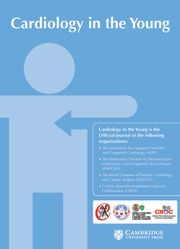No CrossRef data available.
Article contents
Myocardial infarction in a 17-year-old patient diagnosed with MPOD II syndrome
Published online by Cambridge University Press: 04 October 2024
Abstract
Microcephalic osteodysplastic primordial dwarfism (MOPD) syndrome type 2, caused by a mutation in the PCNT gene (21q22.3), is a rare autosomal recessive disorder. Patients present with bone dysplasia, insulin resistance, kidney diseases, and cardiac malformations, making them prone to vascular diseases. Cardiomyopathy, hypertension, and coronary diseases are documented. The prognosis is associated with cerebrovascular complications.
We report a case of a patient with MOPD type II who suffered a myocardial infarction in our institution. Informed consent for publishing was obtained.
A 17-year-old female with MPOD II syndrome (20 kg and 86 cm) was referred for chest pain. Thoracic pains had been occurring for over a month, increasing in intensity, with an episode prompting emergency consultation. Initial tests revealed elevated troponin and an inflammatory response. Electrocardiogram (ECG) showed ST-segment depression and elevation. Echocardiography revealed hypokinetic inferior walls with moderate concentric hypertrophy. A coronary CT scan showed subendocardial hypodensity. Diagnostic coronary angiography revealed tri-branch lesions and almost complete stenoses or occlusions on the circumflex artery (Image). No indication for interventional treatment due to diffuse atheromatous lesions. Exclusive medical treatment was initiated.
MPOD II syndrome is associated with cardiac malformations and neurovascular complications, including myocardial infarction. Regular ECG monitoring is advisable. Active surveillance for coronary diseases is necessary from adolescence. Recognising this complication allows for prompt intervention. This case highlights the need for specific monitoring and prompt management of chest pain in patients with MPOD II syndrome. Primary prevention could mitigate the occurrence of coronary events in this high-risk population.
- Type
- Brief Report
- Information
- Copyright
- © The Author(s), 2024. Published by Cambridge University Press



